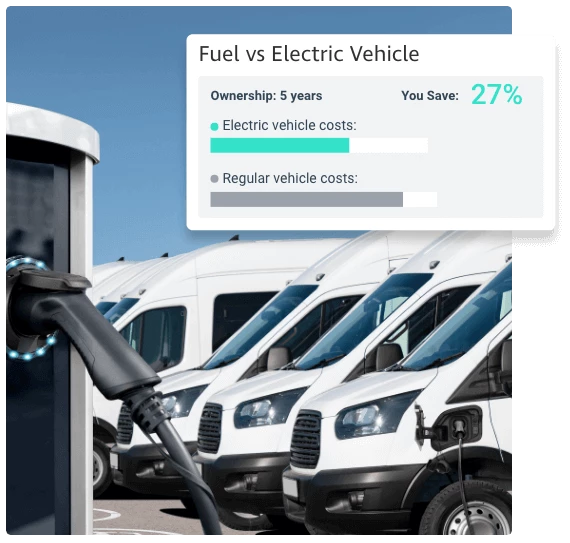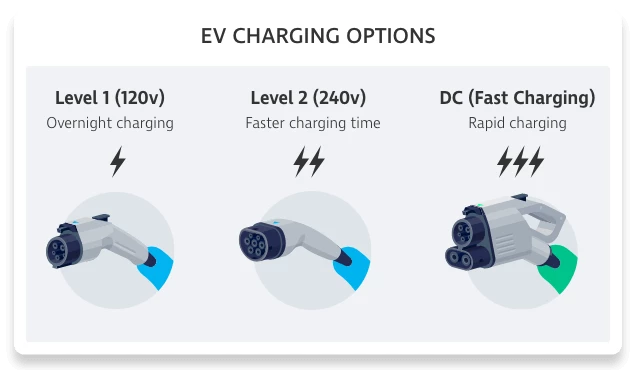Key Takeaways
Fleet electrification is becoming more common as businesses seek to reduce their carbon footprint and lower fuel costs. As more fleet operators make the transition to electric vehicles (EVs), careful infrastructure planning becomes necessary to support efficient charging operations.
Here are five key considerations for fleet electrification infrastructure planning. With these objectives in mind, fleet operators can make informed decisions and maximize the benefits of their electric fleets.
Table of Contents
- Why are Fleets Turning Electric?
- Five Key Charging Considerations for Fleet Electrification Planning
- See Why TN360 is the Best Choice for Mixed Fleets
Why Are Fleets Turning to Electric?
There are both pragmatic and philosophical reasons to consider when assessing a transition to an electric fleet. Companies with fleet vehicles can play a pivotal role in reducing the carbon footprint of transportation, and beyond environmental considerations, there are also financial incentives, including substantial maintenance cost savings and eliminating reliance on fossil fuels. With 39% of fleet operators stating that rising fuel cost is their top business challenge, easing pain at the pump is a smart business strategy.
Transitioning to an electric fleet is often a medium- to long-term process. For this reason, it is crucial to have a fleet management software solution like Teletrac Navman’s TN360 that is capable of supporting mixed fleets comprising both internal combustion engine (ICE) vehicles and electric vehicles (EVs), thanks to its robust features and user-friendly design.

Five Key Charging Considerations for Fleet Electrification Planning
Fleets of all sizes can successfully transition to electric vehicles, however, fleet electrification requires careful infrastructure planning. Here are five details to consider before beginning fleet electrification.
Understand the Specific Needs of Your Fleet
Before embarking on fleet electrification, it's essential to understand the specific requirements of your fleet. Consider factors such as the size and composition of your fleet, the daily mileage and usage patterns of different vehicles, and any plans for future expansion.
Conducting a comprehensive assessment will help determine the number and types of charging stations needed. This process can also uncover potential challenges that may arise during the transition.
Consider Charging Station Placement and Accessibility
Strategic placement of charging stations is essential to optimising your fleet's charging infrastructure. Identify suitable locations that offer convenient access for drivers and align with your operational needs. Consider factors such as proximity to parking areas, depots, or common routes used by your fleet.
Additionally, assess the availability and capacity of electrical infrastructure to support the charging stations. Collaborating with electricians and utility providers can help ensure that the necessary electrical upgrades are in place to keep your charging infrastructure requirements.
Determine Necessary Charging Speeds and Capacities
Different electric vehicles have varying charging speed requirements. Be sure to evaluate the charging capabilities of your fleet and select the appropriate charging equipment.
Charging options range from Level 1 (120V) to Level 2 (240V) chargers and even DC fast charging stations. Level 1 chargers can be used for overnight charging, while Level 2 chargers offer faster charging times. DC fast charging stations provide rapid charging for vehicles with compatible technology.
By understanding your fleet's charging needs, you can determine the optimal mix of charging equipment to meet your operational requirements.

Optimise Integrations with Energy Management Systems
Integrating your charging infrastructure with energy management systems can enhance the efficiency and cost-effectiveness of your fleet electrification. Consider implementing smart charging solutions that enable load management and optimise charging schedules.
By leveraging energy management systems, you can minimize the impact of charging on peak demand and take advantage of utility rate optimisation programs. Integrating renewable energy sources into your charging infrastructure can further reduce your fleet's carbon footprint.
Invest in Premium Fleet Management and Monitoring Solutions
Advanced fleet management and monitoring solutions are ideal for effective charging operations and ongoing maintenance. Telematics systems allow you to monitor the charging status and usage of individual vehicles, providing real-time insights into charging needs.
Fleet management software can also help streamline scheduling and optimise charging operations based on factors like vehicle availability and charging station capacity. By leveraging data analytics, fleet operators can identify opportunities for cost savings, make informed decisions, and proactively address any charging-related issues that may arise.
See Why TN360 is the Best Choice for Mixed Fleets
Fleet electrification represents a significant opportunity for businesses to reduce their environmental impact and embrace sustainable practices. However, successful implementation requires careful planning and consideration of key charging infrastructure factors. By understanding the needs of your fleet, you can take advantage of the benefits of fleet electrification.
Fleet electrification planning is an ongoing process, and your needs will change as your business evolves. For this reason, invest in flexible and customisable software solutions that are scalable with your business.
Teletrac Navman’s TN360 platform offers AI-powered telematics to support your fleet electrification goals. With comprehensive features designed to deliver real-time data, visibility, and impact for all fleet operations, the advantages offered go far beyond fleet electrification to help you optimize all areas of your operation.
Build your solution today to learn more about how TN360 can support your business.

